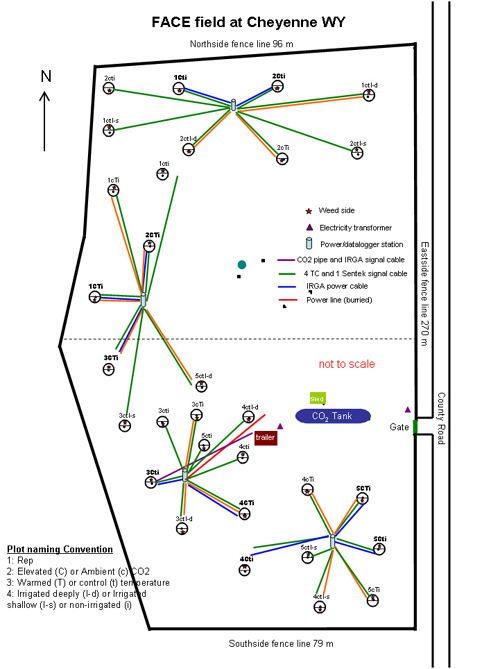| Ecosystem and Design |

|
Ecosystem description 
The experiment is at the USDA-ARS High Plains Grasslands Research Station, located about 10 miles west of Cheyenne, WY USA (41o 11' N lat, 104o 54' W long); elevation 1930 m. The ecosystem is a northern mixed grass prairie, with a plant community of about 55% cool season grasses, 25% warm season grasses, and 20% sedges, forbs and small shrubs. Annual precipitation is 38.4 cm, mean air temperatures are 17.5 Co in summer and -2.5 Co in winter, with maximum July temperature of 27 Co, the average wind speed is 6 m s-1 with gusts to 35 m s-1.
Experimental design
The experiment is currently scheduled to run 5 years (2006-2013). The experiment uses Free Air CO2 Enrichment (FACE) technology designed by Franco Migliette, Institute for BioMeteorology, Florence , Italy), and temperature controlled infra-red heaters (Kimball et al., 2008. Global Change Biology, in press) to achieve CO2 and temperature control. FACE rings and heater arrays are installed in 3.4 m diameter circular plots and expose native northern mixed grass prairie (with and without inter-seeded weeds) to a factorial combination of two CO2 (present ambient [380 ppm], and elevated [600 ppm] CO2, c and C respectively), and two temperature (present ambient, and elevated temperature [1.5/3.0 ?C warmer day/night], t and T respectively) regimes, with five replications each. Two water treatments are imposed on ten additional rings to: 1) simulate the effect of CO2 on plant water use efficiency through water additions, achieved by incremental irrigations to match SWC in Cti plots (designated Is), and 2) large precipitation events, achieved by two large irrigatios, one in early spring, a second in later summer (designated Id), for a total of 30 rings (map). The treatments are designated as follows:
cti - ambient CO2, control temp, non-irrigated
cTi - ambient CO2, infra-red heating, non-irrigated
Cti - elevated CO2 (600 ?L L-1 CO2), control temp, non-irrigated
CTi - elevated CO2, infra-red heating, non-irrigated
ctIs - ambient CO2, control temp, irrigated (to simulate CO2 water savings)
ctId - ambient CO2, infra-red heating, irrigated (to evaluate water-temp responses)
Each of the rings is split into two sections by a 25 cm steel flange. One side features a northern mixed prairie partitioned into soil and plant sampling areas, plus sections for trace gas measurements, a minirhizotron tube (Bartz Technology) for studying root responses, soil water content (Sentek Envirosmart sensors) and air and soil temperature measurements.
At the initiation of the elevated CO2 treatment in the spring of 2006, 15N will be added in the form of KNO 3. Selected soil and plant samples will assayed for stables isotopes of C, N and O to better track plant/soil nutrient and water dynamics. Periodic measurements of leaf water potential and gas exchange of key species will be monitored, and combined with canopy-scale gas exchange measurements to partition fluxes of CO2 and water. In mid-July, aboveground phytomass will be harvested by species, and plant samples assayed for biomass and isotopes of C and N as well as forage quality attributes. Critical plant developmental stages and demography will be monitored. Destructive (soil cores, root in-growth) and non-destructive (minirhizotron) root sampling will determine root growth and plant nutrient dynamics. Soil core sampling (various times and depths) will assess root biomass, soil organic matter, forms and amounts of soil C and N, and N mineralization to better understand N dynamics. Plant pathogens and viruses will be investigated and related to global change treatments. Measurements of N2O, CH4 and CO2 fluxes will be taken periodically. Continuous monitoring of soil water content and temperature to depths and an on-site weather station will monitor plot environments. Data will be directly interpreted, and also used in modeling exercises to forecast long-term system responses to global change.
The area on the other side of the ring is devoted to understanding how disturbance and plant invasion interact with elevated CO2 and warming. It is divided into three 70 cm ? 100 cm subplots. Two subplots are partially disturbed (plot diagram) to a depth of 10 cm. Of these, one has been seeded with 10 species, comprised of 5 native/exotic species pairs. Each pair was chosen to maximize the functional and, where possible, phylogenetic similarity between the native and the exotic species. To allow effects of origin (native/exotic) to be separated from effects of seral stage, the pairs include annuals (Descurainia pinnata/Descurainia Sophia, Chenopodium lepidifolium/Salsola iberica), biennials (Grindelia squarrosa/Centaurea diffusa), and perennials (Artemisia frigida/Linaria dalmatica, Ambrosia tomentosa/Cardaria draba). The final subplot contains a single invasive species Linaria dalmatica, the most common invader at the site, transplanted into undisturbed mixed prairie.
The invasive species vs. NMP areas are randomly assigned within each ring. An approximate 20 cm wide buffer strip prevents sampling at the outer circle edge where accurate CO2 control in the elevated CO2 rings is not possible and where plant-mediated edge effects prevail.
|
|
|
| Main Page | Design | Tech Overview | Staff | References | Photos | News |


